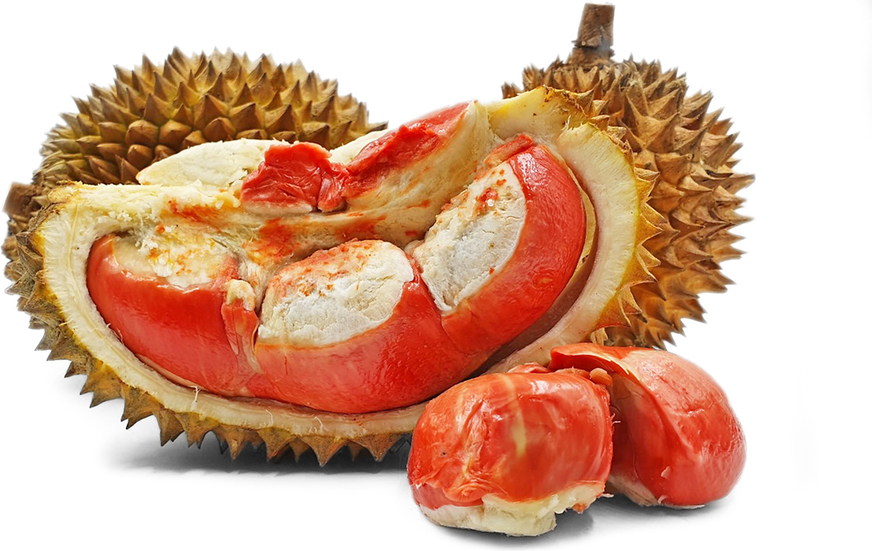


Red Banyuwangi Durian
Estimated Inventory, lb : 0
Description/Taste
Red Banyuwangi durians are small to medium, oval to oblong fruits, averaging 10 to 20 centimeters in length, and are covered in broad spikes. The sharp exterior is generally brown, and underneath the pointed surface, the thick rind has a fibrous consistency that can be sliced or torn open to reveal multi-lobed flesh, surrounded by a white to cream-colored, spongy pith. The flesh widely ranges in color, depending on the growing conditions and variety, and can be found in bright red, orange, and salmon hues, sometimes featuring a variegated blend or striping of all three colors. The flesh is also smooth, slippery, and soft with a creamy consistency and encases flat seeds. Red Banyuwangi durians will vary in taste depending on the specific variety and region grown, but typically contain a sweet flavor with tannic, mildly nutty, and berry-like notes.
Seasons/Availability
Red Banyuwangi durians are available in the summer through early fall.
Current Facts
Red Banyuwangi durians, botanically classified as Durio graveolens, are rare, tropical fruits belonging to the Malvaceae family. The name Banyuwangi was given in honor of a region within Indonesia known for its red durian species. The pigmented durians are also known as Merah durians, as merah in Indonesian translates to mean “red,” a descriptor used to encompass many different varieties of durians with red, orange, salmon, to multi-colored flesh. Red Banyuwangi durians are thought to be descendants of bright red-fleshed, wild durian varieties found throughout Malaysia, East Java, and Borneo. It is believed that these wild varieties have successfully bred with other durian species over time, both naturally and through durian breeders, creating a wide array of cultivars with varying shades of orange, red, and pink flesh. Red Banyuwangi durians are favored for their rarity and colored flesh. The fruits are difficult to find outside local markets within the growing regions and are only available in limited quantities during the season.
Nutritional Value
Red Banyuwangi durians are an excellent source of vitamin C, an antioxidant that reduces inflammation and strengthens the immune system, and are a good source of anthocyanins, pigments found within the flesh that contribute to overall daily health. The fruits are also a good source of vitamin B6, manganese, copper, iron, and potassium, and contain some magnesium, zinc, folate, and calcium.
Applications
Red Banyuwangi durians are primarily consumed fresh, out-of-hand, as their uniquely colored flesh and mild flavor is showcased when raw. The fruits are favored for their rarity, and the spiked husk is typically sliced and torn open to reveal the bright lobes of flesh, removed one by one as they are eaten. Beyond raw consumption, Red Banyuwangi durians are frequently blended with sugar into a paste-like filling and are incorporated into crepes, puff pastries, cakes, and tarts. They can also be mixed into ice cream or served with sticky rice. In Sabah, a state located on the island of Borneo, Red Banyuwangi durian is featured in a traditional condiment known as sabah tempoyak, which is red-fleshed durian preserved in oil and salt. The mixture is also flavored with chile peppers, anchovies, garlic, and onions and has the consistency of a dip or thick, creamy spread. Beyond condiments, Red Banyuwangi durians can be mixed into curries and fried rice dishes. Red Banyuwangi durians pair well with coconut milk, passion fruit, mint, lemongrass, vanilla, dark chocolate, spices such as cinnamon, cloves, and cardamom, tamarind, and peanuts. Whole, unopened durians will keep for a couple of weeks when stored in a cool location. Once sliced, the flesh is best consumed immediately for optimal flavor and can be stored for an additional 2 to 3 days in the refrigerator.
Ethnic/Cultural Info
In East Java, Indonesia, Banyuwangi is a well-known region for its Merah or red-fleshed durians. Experts have discovered over sixty-five variants of red-fleshed durians within the area, and it is believed that some of these variants have been in existence for over one hundred years. The different types of red-fleshed durians are heavily studied by the Red Durian Research and Development Center in order to preserve the mother trees and establish new, documented varieties. Some of the fruits are also being selected and trialed for potential commercial cultivation. Besides research, Banyuwangi is home to local fruit festivals where Merah durians are highly advertised and promoted through free samples to visitors. After sampling the different varieties, festival attendees can also purchase large quantities of the red-fleshed durians to take home as gifts for friends and family.
Geography/History
Red Banyuwangi durians are believed to be native to Indonesia and have been growing wild since ancient times. The red-fleshed, wild fruits were first recorded by Italian botanist Odoardo Beccari in the late 19th century near Kuching, Sarawak. There are many different varieties generally categorized under the name Merah or Red Banyuwangi durian, and over time, even more types have been created with varying flavors, textures, and flesh colorings. Today Red Banyuwangi durians can be found in regions spanning across Peninsular Malaysia, East Java, Borneo, and other tropical regions of Indonesia and Malaysia.
Recipe Ideas
Recipes that include Red Banyuwangi Durian. One
| Year Of The Durian |
|
Red Durian Tempoyak |
| Kuali |
|
Chicken and Durian Curry |
| The Sugar Crumble |
|
Durian Puffs |
| Serious Eats |
|
Durian Smoothie |
| Food dot com |
|
Durian Cake |
| Foodiva's Kitchen |
|
Red Durian Quick Rolls |




